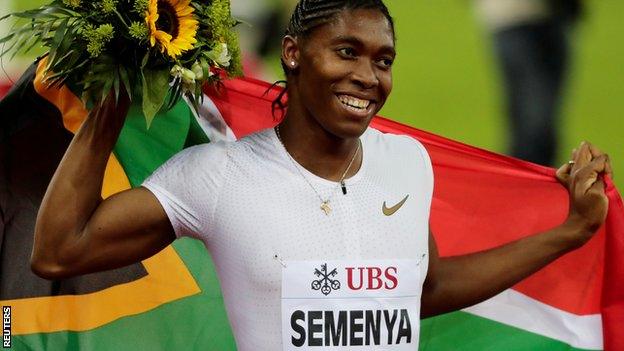Caster Semenya Q&A: Who is she; what is DSD; why is her case important?
- Published

Semenya is the fourth fastest woman of all time over 400m
Potentially one of the most pivotal moments in modern sport occurred not on a track, pitch or court, but in a plush office building in the Swiss city of Lausanne on Wednesday.
The Court of Arbitration for Sport (Cas) rejected Caster Semenya's challenge of rules meaning athletics' world governing body can restrict testosterone levels in female runners.
Who is Caster Semenya?
In short, one of the most dominant stars of modern athletics.
A double Olympic gold medallist and three-time world champion over 800m, the 28-year-old South African has won her past 29 races over the distance.
However, since her rise from unknown teenager to world champion in 2009, her gender, and possible advantages in her biology, have come under scrutiny.
The results of gender testing carried out 10 years ago have not been made public, although media reports claimed it showed both male and female characteristics including a higher-than-normal level of testosterone.
Semenya wins 800m gold at the 2017 World Championships
The International Association of Athletics Federations, which runs the sport, proposed a rule to restrict the level of testosterone permitted in female runners in events between 400m and a mile.
Semenya unsuccessfully challenged the proposal.
What are disorders/differences of sex development (DSD)?
People with a DSD do not develop along typical gender lines.
Their hormones, genes, reproductive organs may be a mix of male and female characteristics.
The term "disorders" is controversial with some of those affected preferring the term "intersex" and referring to "differences in sex development".
What next after diagnosis?
Most people with a DSD stay with the gender they were assigned as a baby. However others, who feel their assigned gender doesn't represent who they are, may choose to change their gender.
People with a DSD may be infertile and need hormone therapy and psychological support to help them come to terms with their condition.
What about elite athletes like Semenya?
Research commissioned by the IAAF showed in 2017 that female athletes with elevated testosterone had "a competitive advantage", claiming that high testosterone was responsible for as much as 3% improvement in runners.
However those findings were contested by Semenya and her team.
Caster Semenya: The full interview
They claim it is not clear how much DSD athletes benefit from their naturally higher levels of testosterone.
During the early 1990s, Spanish hurdler Maria Jose Martinez-Patino successfully fought against a ban imposed after she was discovered to have XY chromosomes typically seen in men.
She demonstrated that her condition made her insensitive to the 'excess' testosterone in her blood.
Why is Semenya's case so important?
Sport has traditionally been divided into male and female categories, but Semenya's case and the science it has brought to the fore shows it may be an artificially binary distinction.
that, had the verdict gone against the IAAF, athletics might have introduced an 'open' category that men and women could, in theory, compete in side by side, and a 'protected' category based on hormone levels, rather than gender.
And what about the future for Semenya now she has lost the case?
A leading sport scientist has over 800m if she reduces her testosterone in line with the proposed limits.
She could change to a longer distance. She has run the 5,000m twice this season, winning on both occasions.